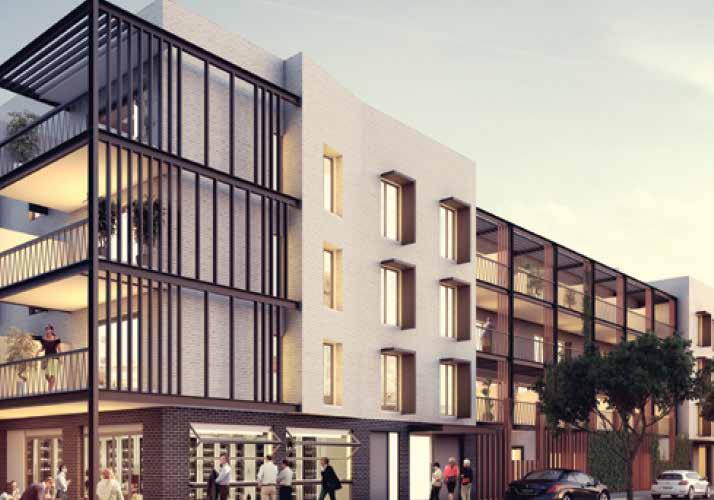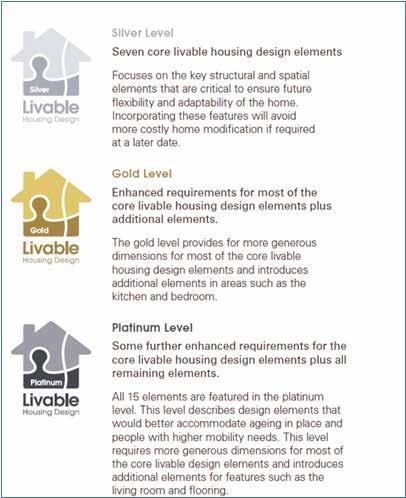
12 minute read
Direction 9 A Centre with Housing for All
from Draft Campsie Master Plan
by cbcity
Direction 9
A Centre with Housing for All
To support Campsie’s diverse population, we need to ensure housing is well designed, appropriately located, and meets the needs and expectations of the community. Housing within the Campsie Town Centre will range from low to medium and high density living. Low and medium density housing will be retained in the north-west and south-east of the Town Centre, whilst new, high density living ranging from three storey walk-up type apartments to high-rise living, will be focused where there is the greatest amenity, around Campsie Station and the centre core, the Cooks River and the medical precinct around Canterbury Hospital.
Planning Instruments will mandate the delivery of a range of housing types to suit different needs and lifestyles. Diverse housing will include a mix of sizes, universal design, housing for students, seniors, people with disabilities, families and singles across a range of land use zones.
What do we know?
· It is important to align housing growth and infrastructure, as a Strategic Centre receiving a Metro Station, Campsie has an important role to play in housing delivery. · Campsie currently has a mix of housing typologies, ranging from low density, single detached houses to medium and high density town houses and apartments. · Some housing, particularly apartment and shop top housing, delivered in Campsie in the past has been of a low quality. The community expect higher quality housing in the centre. · Compared to many of the suburbs that surround the centre, Campsie provides lower cost housing options. · Many lower income households live in Campsie. Nearly a third of Campsie households make less than $1,000 a week (< $51,999 per year). · Nearly half of all household in Campsie rent.
Renters are more vulnerable to the impacts of housing unaffordability. · Gentrification is an ongoing issue is
Campsie, this process can displace existing lower income households for a centre. · The type of household in in Campsie are similar to that of CBCity and Greater
Sydney, with families being the dominant household type (48%), followed by couples (30%). · CBCity’s Housing Strategy has identified a need for 5,600 new homes in the Campsie
Town Centre with approximately 760 new homes within the node between
Canterbury Road and Beamish Street. · It is necessary to increase the capacity of our planning controls in Campsie.
Current controls do not have capacity to accommodate targeted dwelling and population growth to 2036. What are we proposing?
The Master Plan seeks to provide a contemporary approach to planning for housing in the Campsie Town Centre, which meets the needs and expectations of the community. The Master Plan has considered the need for variety and diversity, as well as quality that will meet the needs of its future community. The Master Plan promotes housing that is of a high quality and sustainable whilst offering the locational amenity of being in one of Greater Sydney’s most dynamic centres.
The Master Plan also provides objectives and actions to increase housing supply and deliver affordable rental housing as part of new developments. This will help mitigate the impacts and gentrification and enable low, low and low-moderate-income households remain in Campsie. Campsie currently provides lower cost housing compared to other neighbouring centres. As Campsie realises its role as a Strategic Centre, house prices are likely to rise, leading to greater instances of housing stress.
The planning system alone is unlikely to be able to address the housing affordability challenges of residents, but an active affordable housing strategy can contribute to a reduction in housing stress.
The Master Plan will also set guidance on providing for the diverse mix of housing typologies, sizes and tenures that cater to the needs of people at all stages of their lives. This will be achieved through objectives in the Local Environmental Plan that aim for a range of housing. Development Control Plan controls will provide minimum requirements for unit mixes and universal design controls for people with disabilities and to allow ageing in place.
Housing stress is defined as households earning in the lowest 40% of the Sydney Metropolitan Area paying rent or mortgage repayments greater than 30% of their household income.
Reference: AHURI, Understanding the 30:40 indicator of housing affordability stress
Implementation of Council’s Affordable Housing Strategy will facilitate the delivery of affordable housing within Campsie. Affordable rental housing will help alleviate housing stress and enable low to moderate income workers to live in Campsie.
Objective 9.1
Increase residential capacity in Campsie Town Centre to meet our targeted population growth by 2036
The South District Plan requires all Councils in Sydney to delivery new homes to accommodate projected population growth by 2036. The Local Strategic Planning Statement and Council’s Local Housing Strategy sets a target to deliver 50,000 new homes in CBCity. Campsie, with its transport and infrastructure investment, is well-placed to accommodate a large proportion of new dwellings in the Local Government Area.
The Housing Strategy allocates a target of 5,600 new homes in the Campsie Town Centre alongside 760 new homes at the Canterbury Road and Beamish Street node by 2036. The Housing Strategy recommended a revision to planning controls to increase dwelling delivery capacity in the Town Centre, which is a key action of this Master Plan.
The Master Plan will increase dwelling capacity across the Campsie Town Centre. Growth will be distributed within the areas identified in the Campsie Intensification Strategy. The Intensification Strategy is a more dispersed approach to growth to ensure new housing can be delivered in a manner that retains overall character and form of Campsie. Increases to residential dwelling capacity will occur across mixed use and residential land use zones. This will be achieved by increasing height and floor space ratios in our Local Environmental Plan. Some areas in Campsie are currently not subject to a floor space ratio, including in the B2 Local Centre Zone and along Canterbury Road. A ‘base’ floor space ratio will be provided for these sites based on the current height limit.
Actions
9.1.1 Increase residential dwelling capacity consistent with the intensification strategy, land use strategy and the proposed height and floor space ranges outlined in this Plan.
9.1.2 Introduce a ‘base’ Floor Space Ratio control in areas of Campsie that currently do not have an Floor Space Ratio control. This should be based on the existing height of building controls
Height Approximate Floor Space Range 3 storeys 1.25:1 4 storeys 1.5:1 5 storeys 1.5:1 - 2.4:1 6 storeys 1.5:1 to 2.2:1 7 storeys 2.0:1 to 2.2:1 8 storeys 1.7:1 to 2.8:1 10 storeys 2.7:1 to 3.8:1 12 storeys 2.7:1 to 3.7:1 15 storeys 3.5:1-3.9:1 16 storeys 3.1:1 to 5.3:1 20 storeys 4.1:1 to 6.2:1
This FSR range is indicative. Final FSR for each block will be based on final testing of the Master Plan, and may vary based on land use, lot typology, site coverage controls and other design factors.

Proposed Building Heights

Proposed building heights per building typology Up to 3 storeys Up to 4 storeys Up to 5 storeys
Up to 6 storeys Up to 7 storeys Up to 8 storeys Up to 10 storeys Up to 12 storeys Up to 15 storeys Up to 16 storeys Up to 20 storeys No change to height as part of this plan Heritage Existing Heritage Items (CLEP 2012) and properties under investigation for Heritage Significance Open Spaces and Connectivity Existing Open Spaces Proposed Open Spaces Cooks River Foreshore Landscape Management Area Potential New Pedestrian/Cycle Links/Service Laneways Building heights in meters will vary according with land use The heights shown on this plan are inclusive of all incentives Area subject to future investigation and detailed master plan Building height up to 20 storeys with expansion of Lofts Gardens
1:10,000 (A3) 0 100m 200m
Objective 9.2
The ongoing loss of affordable dwellings through redevelopment and gentrification, combined with increasing housing costs, is leading to an undersupply of affordable accommodation in Campsie. The lack of low cost housing detrimentally affects the quality of life of individuals and families. Households are likely to sacrifice other basic necessities to pay for housing. This can lead to social disadvantage and inequality in cities.
It also has impacts on employment growth and economic development. The loss of young families and workers in lower paid service jobs can adversely affect local economies by reducing the local works in population serving sectors.
Affordable Housing
Affordable housing is different to the concept of housing affordability. Housing affordability refers to the relationship between housing costs and household incomes (if housing costs rise more quickly than income, housing affordability decreases). Affordable housing is a specific type of housing defined under the Environmental Planning and Assessment Act 1979.
Affordable housing means housing that specifically targeted for people on very low, low or moderate incomes as set out in the Canterbury Bankstown Affordable Housing Strategy. It is generally subsidised or offered at below market rents and managed by Community Housing Providers, who are not-for-profit organisations that build and/or manage housing. Local government’s mandate to deliver affordable housing is enshrined in the Environmental Planning and Assessment Act 1979. Section 5(a)(viii) identifies as an objective of the Act, the “maintenance and provision of affordable housing.”
Local government has a role and an obligation to both preserve and create more affordable housing through a number of policies and planning instruments for application at its discretion. State Environmental Planning Policy No. 70 – Affordable Housing (Revised Schemes) is the overarching planning mechanism that allows councils to prepare an Affordable Housing Contribution Scheme for certain precincts within Local Environmental Plans. Council’s affordable housing contribution scheme will require approval by the Planning Minister to incorporate into its Local Environment Plan.
We are creating an Affordable Housing Contribution Scheme for Campsie Town Centre. It seeks to maximise affordable housing within new development and is supported by financial feasibility analysis. Council will enable developments to have access to an incentive height and floor space ratio control if they provide an affordable housing contribution of 3% of total dwellings of a development or a monetary contribution of $198 per square metre* of the residential gross floor area of the development. In accordance with Council’s Feasibility Study (Atlas, 2021), this rate is considered financially feasible for developments.
Development sites providing infrastructure on-site or providing substantial proportions of the building as employment generating floor space, will not be required to make affordable housing contributions.
* Note: Contribution rates will be adjusted on a quarterly basis, being the first days of March, June, September and December, to ensure that the contributions reflect the cost associated with the provision of affordable housing. Rates are adjusted with reference to movements in the median price for strata dwellings in the Canterbury Bankstown LGA. The median strata dwelling price is published quarterly in the NSW Government Rent and Sales Report, Table: Sales Price – Greater Metropolitan Region – Strata. The Rent and Sales Report is available on the NSW Government, Family and Community Services website.
Actions
9.2.1 Introduce an Affordable Housing Contributions Scheme in the Local Environmental Plan as part of achieving an incentive height and floor space ratio, requiring new developments to provide 3% of total dwellings as affordable dwellings, or a monetary contribution of $198 per square metre* of total residential gross floor area to be dedicated to the development of affordable housing.
Developments providing on-site infrastructure and/ or substantial proportions of floor space for employmentgenerating floor space will be exempt from the provision of affordable housing.
Objective 9.3
Increase housing diversity to meet the needs of people and all stages of life
Neighbourhoods with a range of housing types and sizes help ensure people can more readily meet their housing needs throughout their lifecycle, remaining in the area where they have existing networks. Campsie will have an increasing mix of households living in the centre by 2036, including family, single and group households. Council will provide for a diverse mix of housing typologies, sizes and tenures that cater to the needs of people at all stages of their lives in Campsie. Housing will be provided to meet the various needs of different people including:
· Single and family households. · Seniors. · People with disabilities (temporary and permanent). · Students. Local Environmental Plans zone objectives will require a mix of dwelling types and sizes to cater to different households. The Development Control Plan will stipulate the proportion of 1, 2 and 3-bedroom units in shop top housing and residential flat buildings. This will help ensure that a range of housing options are delivered to cater to households of different sizes and types.
Housing mix is only one component of housing diversity. The provision of adaptable housing is essential to a fair and equitable approach to housing delivery. Council’s draft consolidated Development Control Plan includes controls requiring new homes achieve universal design, Campsie Town Centre will rely on the relevant Development Control Plan to ensure new housing aligns with the Livable Housing Design Guidelines. Actions

9.3.1 Specify the minimum unit mix rate for residential flat buildings and shop top housing with more than 20 dwellings: · Studio: 5-10% · 1 bedroom: 10-30% · 2 bedroom: 40-75% · 3+ bedroom: 10-45% 9.3.2 Require new dwellings that require Development Consent to comply with the Livable Housing Design Guidelines in the DCP for Bankstown City Centre: · Residential Flat Buildings and Shop Top Housing: A minimum 20% of new dwellings must achieve the Silver Standard; and a minimum 20% of new dwellings must achieve the Gold Standard. However, it is noted that shop top housing will not deliver dwellings at the ground floor as this would be inconsistent with the LEP definition. · Multi Dwelling Housing and Attached Dwellings: A minimum 20% of new dwellings must achieve the Silver Standard; and a minimum 20% of new dwellings must achieve the Gold Standard. 9.3.3 Develop LEP and DCP Controls to increase the quality of housing design for a range of housing types which achieves the following: · Functional and rational internal design layouts for flexibility of use and quality of experience · Adequate natural light and ventilation through provision of windows, suitable orientation of rooms and generous floor to ceiling heights in all habitable rooms · Generous size and dimensions of private open space and landscaping (where practical) · Acoustic and visual privacy through appropriate setbacks, fencing, acoustic attenuation, window orientation and finished floor levels of habitable rooms · Sizeable storage areas · Generous dwelling sizes for larger households and to provide flexibility for working from home. · Flexibility with spaces for working from home, kids play and family friendly designs. · The above will need to be considered in the context of State Environmental Planning Policy No 65 - Design Quality of Residential Apartment Development and the proposed Design and Place State Environmental Planning Policy being developed by the NSW State Government,










